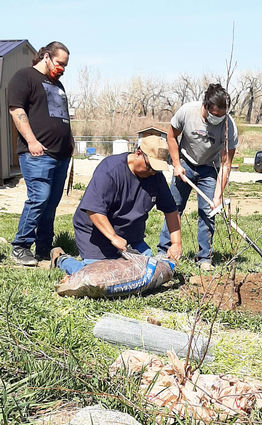Tree Planting Demonstration Was Well-Attended
May 12, 2021

While explaining the benefits of pruning, Hillary Maxwell, the Family Consumer Science MSU Extension Agent for the Fort Belknap Reservation, shows those attending the tree planting event last week the proper procedures for pruning a fruit tree.
On May 6, the tree planting demonstration held at the Aaniiih Nakoda College (ANC) Greenhouse had approximately sixty people in attendance as USDA Extension Program Director Manny Morales and Hillary Maxwell, the Family Consumer Science MSU Extension Agent for the Fort Belknap Reservation, delivered their presentations.
Because the give-away was so well-attended, the fruit trees and fruit shrubs ran out quickly. In fact, not all those who braved the road construction were rewarded with plants. However, the handouts with information pertaining to planting and caring for trees and shrubs were plentiful and the information valuable.
With the assistance of three student interns, Morales demonstrated the planting technique for an apple tree, emphasizing the need for a location with six or more hours of direct sunlight daily and where the soil drains well so as to avoid root rot.
As he prepared the hole, Morales explained the need for a planting space approximately twice the diameter of the root system and two feet deep. Once all of the weeds and grass have been removed, the gardener should place some of the loose soil back into the hole and loosen the soil on the walls of the planting hole so the roots can easily penetrate the soil. Spreading the tree roots on the loose soil, making sure they are not twisted or crowded in the hole, is another critical step. Morales continued to replace soil around the roots, firming the soil to ensure it surrounds the roots but taking care to remove any air pockets. Once the tree was planted, he mulched it with wood chips and described how to stake a tree and protect it from wildlife by using hardware cloth as a shield.
Morales explained that newly planted trees and shrubs need regular and consistent watering until root systems establish but that over-watering can deplete oxygen from the soil, prevent the roots from absorbing necessary minerals, and make a tree susceptible to rot and infection.
As a transition to her pruning demonstration, Maxwell reiterated the value of adequate planting preparation: "You don't want to put a $50.00 tree in a $2.00 hole," she said. "And be sure to train the tree to reach for water, by gradually watering away from the trunk. To detect the reach of the roots, you can look at the reach of the lateral branches."
She began her pruning by removing several shoots called "suckers" arising from the base of an apple tree growing nearby, explaining how those take energy from the tree. Then, she described the value of pruning a tree to let in more light and air. Removing any branches that are crossing, crowded, or rubbing on each other is another important factor. When selecting which to remove, Maxwell said to keep the most vigorous branches or those which point in the desired direction. The next step is to prune out any branches that are dead, discolored, or damaged.

With the assistance of student interns, USDA Extension Program Director Manny Morales demonstrates proper tree-planting technique.
"Trees should have well-spaced 'scaffold' branches," Maxwell explained. "These are the main branches that rise off the trunk, that help form the canopy, and from which lateral branches develop. These should be spaced up the trunk and should not arise off the trunk directly across from each other, nor directly above another branch."
Maxwell went on to state that "the best branches are more horizontal than vertical. They're stronger, less apt to break in wind and under fruit loads, and they produce more fruit. So remove the more vertical ones."
Because a common mistake of beginning pruners is to cut off too much of last year's growth, Maxwell said: "A good rule of thumb to follow is never take more than one quarter off the tree."
After the two demonstrations, Morales distributed two varieties of apple trees: McIntosh and Honeycrisp; and several fruit shrubs/plants: buffalo berry, strawberries, gooseberries, Montana red currants, and raspberries.







